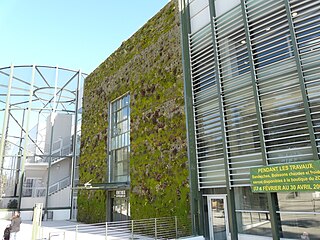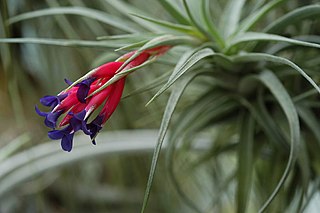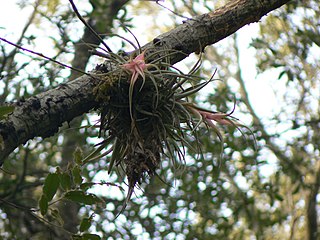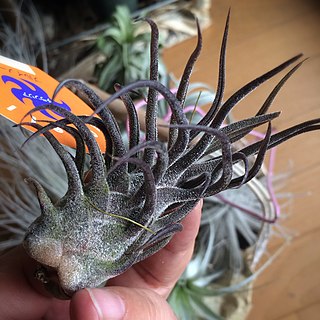
The Bromeliaceae is a family of monocot flowering plants of 75 genera and around 3590 known species native mainly to the tropical Americas, with a few species found in the American subtropics and one in tropical west Africa, Pitcairnia feliciana.

Spanish moss is an epiphytic flowering plant that often grows upon large trees in tropical and subtropical climates. It is native to much of Mexico, Bermuda, the Bahamas, Central America, South America, the Southern United States, and West Indies. It has been naturalized in Queensland (Australia). It is known as "grandpa's beard" in French Polynesia.

Tillandsia is a genus of around 650 species of evergreen, perennial flowering plants in the family Bromeliaceae, native to the forests, mountains and deserts of northern Mexico and south-eastern United States, Mesoamerica and the Caribbean to mid Argentina. Their leaves, more or less silvery in color, are covered with specialized cells (trichomes) capable of rapidly absorbing water that gathers on them.

Tillandsia recurvata, commonly known as small ballmoss or ball moss, is a flowering plant in the family Bromeliaceae that grows upon larger host plants. It grows well in areas with low light, little airflow, and high humidity, which is commonly provided by southern shade trees, often the southern live oak. It is not a parasite like mistletoe, but an epiphyte like its relative Spanish moss.

Wallisia cyanea is a species of flowering plant in the bromeliad family, native to the rainforests of Ecuador. An epiphytic perennial growing to 50 cm (20 in) high by 50 cm (20 in) wide, it has stemless rosettes of thin, recurved leaves and paddle-shaped spikes of 20 pink bracts with violet flowers, in spring and autumn.

Tillandsia caput-medusae is a species of flowering plant in the bromeliad family, Bromeliaceae, subfamily Tillandsioideae. Common names include octopus plant and medusa's head. An epiphyte native to Central America and Mexico, T. caput-medusae is a commonly cultivated bromeliad species. The thick, channeled, tapering and twisting leaves are up to 25 cm (9.8 in) long and are covered in fine gray hairs. The rosette of leaves arise from an inflated pseudobulb. Pups are produced after blooming, as is usual with most Tillandsia species.

The Montpellier Zoological Park is a French zoological park located in the region Occitanie, in the north of the city of Montpellier.

Tillandsia aeranthos is a species of plant in the genus Tillandsia. This species is native to southern Brazil, Paraguay, Uruguay, and Argentina.

Tillandsia balbisiana, common name northern needleleaf, is a species of bromeliad in the genus Tillandsia. This species in native to Mexico, Central America, Colombia, Venezuela, the West Indies, and Florida.

Tillandsia bulbosa, the bulbous airplant, is a species in the genus Tillandsia. It is widespread across Central America, the West Indies, southern Mexico, and northern and eastern South America.
Tillandsia capitata is a species in the genus Tillandsia. It is native to Mexico, Honduras, Cuba and the Dominican Republic.

Tillandsia brachycaulos is a species in the genus Tillandsia. It is native to Mexico, Central America, and Venezuela.

Tillandsia erubescens is a species of epiphytic plants of the genus Tillandsia. This species is endemic to Mexico, found over much of the country from Chihuahua to Oaxaca.

Tillandsia pruinosa, is a species of flowering plant in the Bromeliaceae family. It is commonly known as the fuzzywuzzy airplant. This species is native to northern South America, Central America, southern Mexico, the West Indies and Florida.

Tillandsia tenuifolia, the narrowleaf airplant, is a species in the genus Tillandsia. This species is widespread across much of South America and the Caribbean islands.

Tillandsia fasciculata, commonly known as the giant airplant or cardinal airplant, is a species of bromeliad that is native to Central America, Mexico, the West Indies, northern South America, and the southeastern United States. Within the United States, this airplant is at risk of extirpation from the Mexican bromeliad weevil, Metamasius callizona.

Tillandsia ionantha, the air plant, is a species of plant in the genus Tillandsia. This species is native to Central America and Mexico. It is also reportedly naturalized in Broward County, Florida.

Tillandsia utriculata, commonly known as the spreading airplant or the giant airplant, is a species of bromeliad that is native to Florida and Georgia in the United States, the Caribbean, southern and eastern Mexico, Central America, and Venezuela.
Tillandsia baileyi, commonly known as the reflexed airplant or Bailey's ball moss, is a species of bromeliad that is native to southern Texas in the United States and Tamaulipas in Mexico. It is found along the Gulf of Mexico from Kingsville, Texas to Tampico, Tamaulipas. Preferred host plants for this epiphyte include Southern live oak and Texas ebony.

Tillandsia latifolia is a species of flowering plant in the genus Tillandsia. This species is native to Ecuador and Peru. Four varieties are recognized:
- Tillandsia latifolia var. divaricata(Benth.) Mez - Peru, Ecuador
- Tillandsia latifolia var. latifolia - Peru, Ecuador
- Tillandsia latifolia var. leucophyllaRauh - Peru
- Tillandsia latifolia var. majorMez - Peru

















